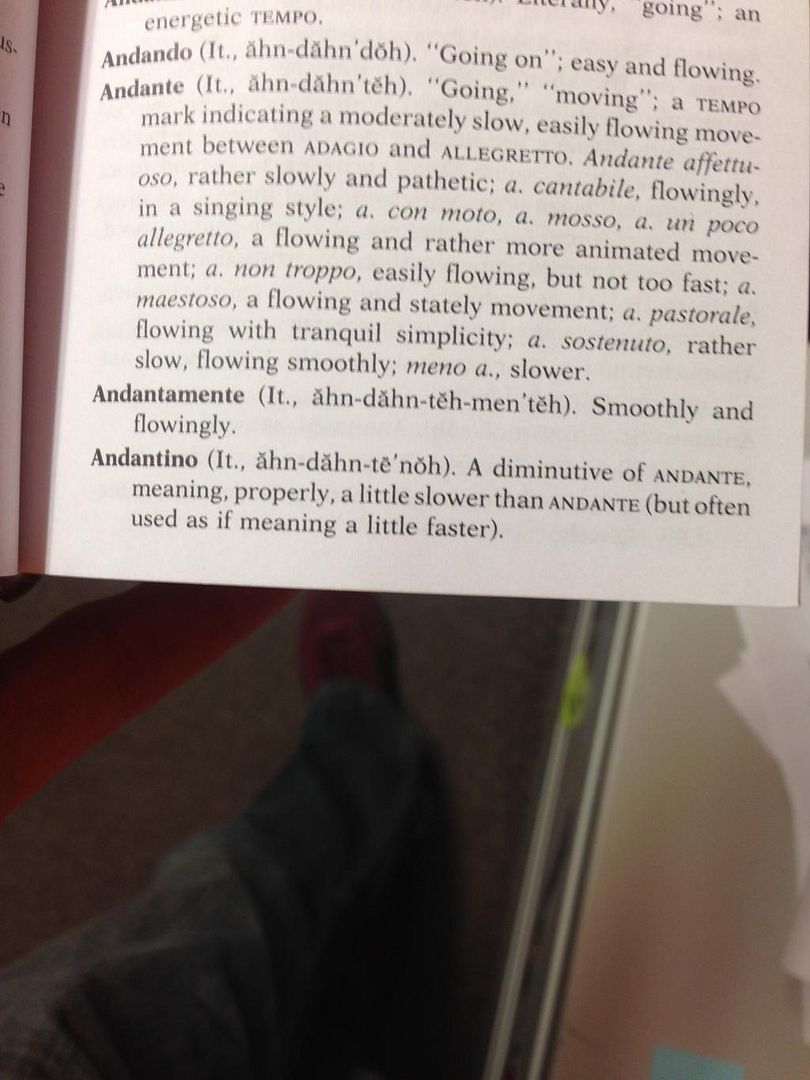Andantino
I have a music dictionary that give a very confusing definition of Andantino.
"A diminutive of Andante, meaning, properly, a little slower than andante (but often used as if meaning a little faster)"
...what?
It's from Schirmer Pocket Manual of Musical Terms

Replies (15)
I think andantino says more about the character of the piece than the tempo. Lighter, somehow. Just my perception.
Andantino is a piece in Suzuki Violin School, book 1, that is played after Allegretto and before Etude.
Oh, wait....
As in the word "piano", there is musician's Italian, and Italian's Italian...
Even in Italian's Italian, doesn't Piano mean Quiet? In chess, the Giuoco Piano means the Quiet Game (as opposed to the King's Gambit). And the 4. d2d3 (as opposed to c2c3) variation is called the Pianissimo.
In my dictionary, piano means slowly as well as softly.
If Andante means moving, Andantio means less moving i.e.slower; If Andante means "moderate, then Andantino means less moderate, so faster.
The dictionary gives "ordinary" or even "second-rate"!!
A simple solution is to ignore what it means and play at a speed that is musically pleasing. LOL
"Forte" means "strong", which isn't necessarily quite the same as "loud".
What irritates me a little in some orchestral scores is the instruction to play fff (or even ffff!),
an instruction that is sometimes compounded by a conductor who is not a string player and
apparently expects us to tear our instruments apart to achieve this dynamic.
In fact, in an orchestral situation, "fff" is the composer's instruction to the orchestra as a whole
to play as loudly as it can, and this dynamic is of course well provided by the good people
in the brass, woodwind and percussion sections. And the rest of us look busy ;)
The '-ino' is a diminutive, so whether you go faster or slower depends on which way you read 'less' andante, slowER or less slow. Metaphoric or literal. And when the piece was written matters, and the nationality of the composer...I agree, just play the music musically....now, what does that mean?
"Forte" means "strong", which isn't necessarily quite the same as "loud".
Yup. And allegro means "lively", not necesserily "fast".
I wonder what Italians think of all this..
A related question which has intrigued me for some time. Does 'andante ma non troppo' mean faster or slower than Andante? Beethoven used it at least twice. In his quartet op131 (4th movement)the full direction is 'Andante ma non troppo e molto cantabile'. Presumably he was trying to be helpful, or at least make the music slightly more 'performer-proof'. But listening to the divergent solutions offered on record I'm not sure he succeeded. For my money the more successful performances are the ones who treat it as 'not too slow'. Glorious music, whatever the tempo.
He did the same trick in Op130 (3rd movement) - 'Andante con moto ma non troppo' and 'poco scherzoso'. In this case I'm not so sure. The direction suggests 'not too fast'. In this instance my favorite performances are among the slower ones but still definitely 'not too slow'. As someone commented above it's the character of the music which matters - this movement needs to be light and playful whatever the tempo.
Tempo indications are routinely ignored, especially by HIPers. Some of their Andantes are faster than my Allegros.
One of my "tests" for great music is to play Presto movements Andante, and they still don't get boring.
Adrian, I was told as a child that Andante meant Walking, which would correspond to your Moving. I would not have thought it meant Moderate, as Moderato is used for that, and, traditionally, is faster than Andante. Also, I would imagine that the Walking referred to in Andante was the liturgical kind, so slower than Moderato (I think marches tend to be headed Moderato). Which would suggest Andantino was somewhere between Andante and Moderato.
Metronome is the cause of this issue.Indication of character has been assigned to Tempo but interpreted
literally lead to a misconception. For example we obviously cant' play Allegro, which mean Joy full,in a slow tempo but not necessarily 12O or 144
This discussion has been archived and is no longer accepting responses.
Violinist.com is made possible by...
Dimitri Musafia, Master Maker of Violin and Viola Cases
Johnson String Instrument/Carriage House Violins
Subscribe
Laurie's Books
Discover the best of Violinist.com in these collections of editor Laurie Niles' exclusive interviews.

Violinist.com Interviews Volume 1, with introduction by Hilary Hahn

Violinist.com Interviews Volume 2, with introduction by Rachel Barton Pine















February 6, 2015 at 11:18 PM · It means that Andantino can mean slightly faster or slower. :)
Maybe somebody Italian can tell us of the correct way to use each term.